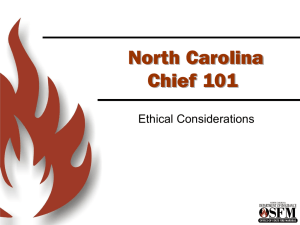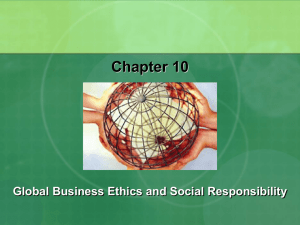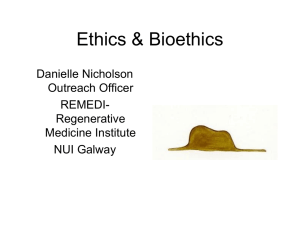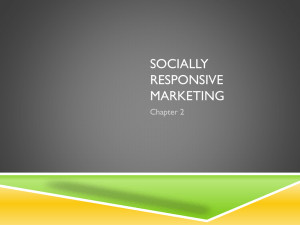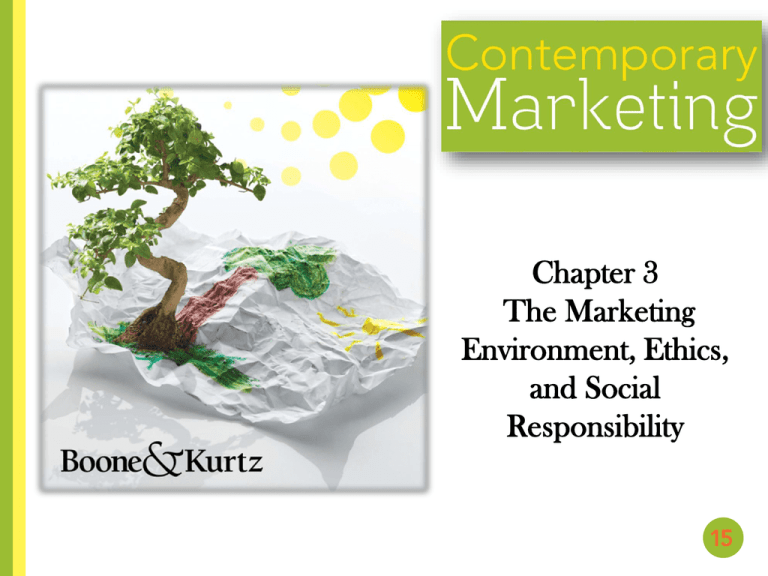
Chapter 3
The Marketing
Environment, Ethics,
and Social
Responsibility
CHAPTER 3 The Marketing Environment, Ethics, and Social Responsibility
Chapter Objectives
1. Identify the five components of the marketing environment.
2. Explain the types of competition marketers face and the steps
necessary for developing a competitive strategy.
3. Describe how marketing activities are regulated and how
marketers can influence the political-legal environment.
4. Outline the economic factors that affect marketing decisions
and consumer buying power.
Copyright © 2012 by South Western, a division of Cengage Learning. All rights reserved.
CHAPTER 3 The Marketing Environment, Ethics, and Social Responsibility
Chapter Objectives
5.
Discuss the impact of the technological environment on a
firm’s marketing activities.
6.
Explain how the social-cultural environment influences
marketing.
7.
Describe the ethical issues in marketing.
8.
Identify the four levels of the social responsibility pyramid.
Copyright © 2012 by South Western, a division of Cengage Learning. All rights reserved.
CHAPTER 3 The Marketing Environment, Ethics, and Social Responsibility
Environmental Scanning
o Collecting external marketing environment
information to identify and interpret potential trends
o Trends may represent significant opportunities or
threats to the company
o Example: CPSC issued a recall of The Princess and the
Frog-themed pendants, citing high levels of cadmium in
the children’s necklaces
Copyright © 2012 by South Western, a division of Cengage Learning. All rights reserved.
CHAPTER 3 The Marketing Environment, Ethics, and Social Responsibility
Environmental Management
o Attainment of organizational objectives by predicting
and influencing the competitive, political-legal,
economic, technological, and social- cultural
environments
o Strategic alliance - Partnership in which two or more
companies combine resources and capital to create
competitive advantages in a new market
Copyright © 2012 by South Western, a division of Cengage Learning. All rights reserved.
CHAPTER 3 The Marketing Environment, Ethics, and Social Responsibility
Copyright © 2012 by South Western, a division of Cengage Learning. All rights reserved.
CHAPTER 3 The Marketing Environment, Ethics, and Social Responsibility
The Competitive Environment
o Interactive process that occurs in the marketplace
among:
o Marketers of directly competitive products
o Marketers of products that can be substituted for one
another
o Marketers competing for the consumer’s purchasing
power
Copyright © 2012 by South Western, a division of Cengage Learning. All rights reserved.
CHAPTER 3 The Marketing Environment, Ethics, and Social Responsibility
The Competitive Environment
o Marketing decisions by individual firms influence:
o Consumer responses in the marketplace
o Marketing strategies of competitors
o Few organizations have monopoly positions
o Monopoly - Market structure in which a single seller
dominates trade in a good or service for which buyers
can find no close substitutes
Copyright © 2012 by South Western, a division of Cengage Learning. All rights reserved.
CHAPTER 3 The Marketing Environment, Ethics, and Social Responsibility
The Competitive Environment
o Some pharmaceutical firms have temporary
monopolies provided by patents on drugs
o Antitrust laws - Designed to prevent restraints on trade
such as business monopolies
o Oligopoly - Few number of sellers in an industry with
high start-up costs which keep out new competitors
Copyright © 2012 by South Western, a division of Cengage Learning. All rights reserved.
CHAPTER 3 The Marketing Environment, Ethics, and Social Responsibility
Types of Competition
o Direct
o Among marketers of similar products
o Example: Alternative suppliers in the cell phone market
such as Verizon and AT&T
o Indirect
o Involves products that are easily substituted
o Example: In the fast-food industry, pizza competes with
chicken, hamburgers, and tacos
Copyright © 2012 by South Western, a division of Cengage Learning. All rights reserved.
CHAPTER 3 The Marketing Environment, Ethics, and Social Responsibility
Types of Competition
o Competition among all firms that compete for
consumers’ purchases
o All firms compete for a limited number of dollars that
consumers can or will spend
o Example: The purchase of a Honda Accord might
compete with a Norwegian Cruise Line cruise
Copyright © 2012 by South Western, a division of Cengage Learning. All rights reserved.
CHAPTER 3 The Marketing Environment, Ethics, and Social Responsibility
Developing a Competitive Strategy
o Competitive strategy - Methods through which a firm
deals with its competitive environment
o Should we compete?
o Depends on firm’s resources, objectives, and expected
profit potential
o In what markets should we compete?
o Allocate firm’s limited resources to the areas of greatest
opportunity
Copyright © 2012 by South Western, a division of Cengage Learning. All rights reserved.
CHAPTER 3 The Marketing Environment, Ethics, and Social Responsibility
Developing a Competitive Strategy
o How should we compete?
o Includes product, promotion, distribution, and pricing
decisions that maximize competitive advantage
o Time-based competition - Strategy of developing and
distributing goods more quickly than competitors
Copyright © 2012 by South Western, a division of Cengage Learning. All rights reserved.
CHAPTER 3 The Marketing Environment, Ethics, and Social Responsibility
Key Environments
o Marketing Environment
o The actors and forces that affect a firm’s ability
to build and maintain successful relationships
with customers.
CHAPTER 3 The Marketing Environment, Ethics, and Social Responsibility
Key Environments
o Aspects of the marketing environment:
o Microenvironment:
o Actors close to the company
o Macroenvironment
o Larger societal forces
Figure 4-1:
Actors in the
Microenvironment
CHAPTER 3 The Marketing Environment, Ethics, and Social Responsibility
The Microenvironment
o Departments within the company impact marketing
planning.
CHAPTER 3 The Marketing Environment, Ethics, and Social Responsibility
The Microenvironment
o Suppliers help to create and deliver customer value.
o Treat suppliers as partners.
CHAPTER 3 The Marketing Environment, Ethics, and Social Responsibility
The Microenvironment
o Marketing intermediaries help to sell, promote, and distribute goods.
o Intermediaries take
many forms.
o Resellers
o Physical
distribution firms
o Marketing services
agencies
o Financial
intermediaries
CHAPTER 3 The Marketing Environment, Ethics, and Social Responsibility
The Microenvironment
o Customer markets must be studied.
o Market types
o
o
o
o
o
Consumer
Business
Government
Reseller
International
CHAPTER 3 The Marketing Environment, Ethics, and Social Responsibility
The Microenvironment
o Successful companies provide better customer
value than the competition
o Size and industry position
help to determine the competitive strategy.
The Microenvironment
• Various publics must also
be considered.
o
o
o
o
Government
Media
Financial
Citizen action
groups
o Local
o General
o Internal
Figure 4-2:
Major Macroenvironmental
Forces
CHAPTER 3 The Marketing Environment, Ethics, and Social Responsibility
The Macroenvironment
o Key Demographic Trends
o World population
growth
o Now 6.2 billion
o Projected to
reach 7.9 billion
by 2025
Seven U.S. Generations
CHAPTER 3 The Marketing Environment, Ethics, and Social Responsibility
The Macroenvironment
o Key Demographic Trends
Changing American
household
Geographic population
shifts
Better-educated, more
white-collar workforce
Increasing Diversity
CHAPTER 3 The Marketing Environment, Ethics, and Social Responsibility
The Economic Environment
o Gross domestic product (GDP) - Sum of all goods and
services produced by a nation in a year
o Economic environment - Factors that influence
consumer buying power and marketing strategies
o Business cycle - Pattern of stages in the level of
economic activity
Copyright © 2012 by South Western, a division of Cengage Learning. All rights reserved.
Economic Cycles
CHAPTER 3 The Marketing Environment, Ethics, and Social Responsibility
Stages in the Business cycle
o Prosperity - Consumer spending is brisk; growth in
services sector
o Recession - Consumers focus on basic, fundamental
products
o Depression - Consumer spending sinks to its lowest
level
o Recovery - Consumer purchasing power increases
Copyright © 2012 by South Western, a division of Cengage Learning. All rights reserved.
CHAPTER 3 The Marketing Environment, Ethics, and Social Responsibility
The Global Economic Crisis
o Business cycles take a severe turn and affect
consumers and businesses across the globe
o Marketers must reevaluate their strategies and
concentrate on their most promising products
Copyright © 2012 by South Western, a division of Cengage Learning. All rights reserved.
CHAPTER 3 The Marketing Environment, Ethics, and Social Responsibility
o Inflation and Deflation
o Inflation: The devaluation of money by reducing
what it can buy through persistent price increases.
o Deflation: Falling prices, better?
Unemployment
o The proportion of people in the economy who do
not have jobs and are actively looking for work.
CHAPTER 3 The Marketing Environment, Ethics, and Social Responsibility
o Income
o Discretionary income: the amount of money
people have to spend after paying for
necessities such as food, clothing, and housing.
o Resource Availability
o Demarketing: the process of reducing
consumer demand for a good or service to a
level that the firm can supply.
CHAPTER 3 The Marketing Environment, Ethics, and Social Responsibility
The International Economic Environment
o Marketers must monitor the economic environment of
other nations
o Global political changes affect international
marketplace
Copyright © 2012 by South Western, a division of Cengage Learning. All rights reserved.
CHAPTER 3 The Marketing Environment, Ethics, and Social Responsibility
The Macroenvironment
o The Natural Environment
– Concern for the natural
environment has grown steadily,
increasing the importance of these
trends:
• Shortage of raw materials
• Increased pollution
• Increased governmental
intervention
• http://www.nba.com/2010/news/09/2
1/adidas-uniforms/index.html
CHAPTER 3 The Marketing Environment, Ethics, and Social Responsibility
The Macroenvironment
Many companies use recycling to help protect natural resources
CHAPTER 3 The Marketing Environment, Ethics, and Social Responsibility
The Technological Environment
o The technological
environment represents
the application of
knowledge in science,
inventions, and
innovations to marketing.
o Applying technology
helps Fidelity improve
customer service
CHAPTER 3 The Marketing Environment, Ethics, and Social Responsibility
The Macroenvironment
o Key Technological Trends
o The technological environment is characterized by
rapid change.
o New technologies create new opportunities and
markets but make old technologies obsolete.
o The U.S. leads the world in research and
development spending.
CHAPTER 3 The Marketing Environment, Ethics, and Social Responsibility
The Political-Legal Environment
o Consists of laws and their interpretations that require
firms to operate under competitive conditions and to
protect consumer rights
o Ignorance or non-compliance can result in fines,
negative publicity, and civil damage suits
Copyright © 2012 by South Western, a division of Cengage Learning. All rights reserved.
CHAPTER 3 The Marketing Environment, Ethics, and Social Responsibility
Government Regulation
o Falls into four historical phases:
o Antimonopoly period of the late 19th and early 20th
centuries
o Protecting competitors during the Great Depression of
the 1930s
o The third phase focused onConsumer protection
o Industry deregulation began in the late 1970s
Copyright © 2012 by South Western, a division of Cengage Learning. All rights reserved.
CHAPTER 3 The Marketing Environment, Ethics, and Social Responsibility
Government Regulation
o Newest regulatory frontier is cyberspace
o Federal and state regulators are investigating ways to
police the Internet and online services
o Privacy and child protection issues are difficult
enforcement challenge
Copyright © 2012 by South Western, a division of Cengage Learning. All rights reserved.
CHAPTER 3 The Marketing Environment, Ethics, and Social Responsibility
Copyright © 2012 by South Western, a division of Cengage Learning. All rights reserved.
CHAPTER 3 The Marketing Environment, Ethics, and Social Responsibility
Copyright © 2012 by South Western, a division of Cengage Learning. All rights reserved.
CHAPTER 3 The Marketing Environment, Ethics, and Social Responsibility
Copyright © 2012 by South Western, a division of Cengage Learning. All rights reserved.
CHAPTER 3 The Marketing Environment, Ethics, and Social Responsibility
Government Regulatory Agencies
o The Federal Trade Commission (FTC) has the
broadest regulatory powers over marketing
o Enforces laws regulating unfair business practices and
stops false and deceptive advertising
o The FTC uses several procedures to enforce laws
o Consent order
o Cease-and-desist orders
Copyright © 2012 by South Western, a division of Cengage Learning. All rights reserved.
CHAPTER 3 The Marketing Environment, Ethics, and Social Responsibility
Other Regulatory Forces
o Consumer interest organizations
o Other groups attempt to advance the rights of
minorities, senior citizens, and other causes
o Self-regulatory groups set guidelines for responsible
business conduct
Copyright © 2012 by South Western, a division of Cengage Learning. All rights reserved.
CHAPTER 3 The Marketing Environment, Ethics, and Social Responsibility
The Social-Cultural Environment
o The relationship between the marketer, society, and
culture
o Marketers must be sensitive to demographic shifts and
changing values
o Increasing importance of cultural diversity
o Example: Univision and Telemundo face growing
competition in Spanish-language television
programming
Copyright © 2012 by South Western, a division of Cengage Learning. All rights reserved.
The Macroenvironment
The Cultural Environment
o Core beliefs are persistent
o Passed from parents
to children; reinforced
by society
o Shape attitudes and behavior
o Secondary cultural values
change and
shift more easily
o Society’s cultural values are
expressed through people’s
views of:
o
o
o
o
o
o
Themselves
Others
Organizations
Society
Nature
The Universe
CHAPTER 3 The Marketing Environment, Ethics, and Social Responsibility
Responding to the
Marketing Environment
o Reactive:
Passive Acceptance and Adaptation
o Companies design strategies that avoid threats and capitalize upon
opportunities.
o Proactive:
Environmental Management
o Use of lobbyists, PR, advertorials, lawsuits, complaints, and contractual
agreements to influence environmental forces.
CHAPTER 3 The Marketing Environment, Ethics, and Social Responsibility
Consumerism
o Social force within the environment that aids and
protects the consumer by exerting legal, moral, and
economic pressures on business and government
o Consumer rights:
o The right to choose freely
o The right to be informed
o The right to be heard
o The right to be safe
Copyright © 2012 by South Western, a division of Cengage Learning. All rights reserved.
CHAPTER 3 The Marketing Environment, Ethics, and Social Responsibility
Ethical Issues in Marketing
o Marketing ethics - Marketers’ standards of conduct
and moral values
o Many companies create ethics programs to train
employees to act ethically
o Employees’ personal values sometimes conflict with
employers’ ethical standards
Copyright © 2012 by South Western, a division of Cengage Learning. All rights reserved.
SOCIAL RESPONSIBILITY IN MARKETING
• Social responsibility Marketing philosophies, policies, procedures, and
actions that have the enhancement of society’s welfare as a primary
objective.
CHAPTER 3 The Marketing Environment, Ethics, and Social Responsibility
Social Responsibility and Ethics
Ethical =
morally right
Socially Responsible =
society views as best
Promote
harmony,
stability
Responsible
marketing
can...
Promote
well-being
Draw
crowds to
events
Influence
elections
CHAPTER 3 The Marketing Environment, Ethics, and Social Responsibility
Copyright © 2012 by South Western, a division of Cengage Learning. All rights reserved.
CHAPTER 3 The Marketing Environment, Ethics, and Social Responsibility
Copyright © 2012 by South Western, a division of Cengage Learning. All rights reserved.
CHAPTER 3 The Marketing Environment, Ethics, and Social Responsibility
Ethics in Marketing Research
o Consumers are concerned about privacy
o Proliferation of databases
o Selling of address lists
o Ease with which consumer information can be gathered
o Several agencies offer assistance to Internet consumers
o The U.S. government maintains a Do Not Call registry
to prevent unwanted telemarketing
Copyright © 2012 by South Western, a division of Cengage Learning. All rights reserved.
CHAPTER 3 The Marketing Environment, Ethics, and Social Responsibility
Ethics in Product Strategy
o Product quality, planned obsolescence, brand
similarity, and packaging raise ethical issues
o Example: Packaging strategy
o Larger packages are more noticeable on the shelf
o Oddly sized packages make price comparison difficult
o Bottles with concave bottoms appear to have more
liquid in them than they do
Copyright © 2012 by South Western, a division of Cengage Learning. All rights reserved.
CHAPTER 3 The Marketing Environment, Ethics, and Social Responsibility
Ethics in Distribution
o What is the appropriate degree of control over the
distribution channel?
o Should a company distribute its products in marginally
profitable outlets that have no alternative source of
supply?
Copyright © 2012 by South Western, a division of Cengage Learning. All rights reserved.
CHAPTER 3 The Marketing Environment, Ethics, and Social Responsibility
Ethics in Promotion
o Truth in advertising is the bedrock of ethics in
promotion
o Marketing to children has come under increased
scrutiny
o Promoting specific products to college students can
raise ethical questions
o Another issue involves firms paying universities for the
use of their logo, team name, or mascot to advertise
products and services to students
Copyright © 2012 by South Western, a division of Cengage Learning. All rights reserved.
CHAPTER 3 The Marketing Environment, Ethics, and Social Responsibility
Ethics in Pricing
o Most regulated aspect of a firm’s marketing activities
o Example: Credit-card companies target consumers
with poor credit ratings and offer them what industry
observers call “subprime” or “fee-harvesting” credit
cards
Copyright © 2012 by South Western, a division of Cengage Learning. All rights reserved.
CHAPTER 3 The Marketing Environment, Ethics, and Social Responsibility
Source: The Four Step Pyramid of Corporate
Social Responsibility from Business Horizons,
Vol. 34, 1991, page 92, Freeman & Liedtka,
“Corp. Social Responsibility.” Reprinted from
Business Horizons © 1991 with permission
From Elsevier.
Copyright © 2012 by South Western, a division of Cengage Learning. All rights reserved.
CHAPTER 3 The Marketing Environment, Ethics, and Social Responsibility
Marketing’s Responsibilities
o Corporate responsibility covers the entire framework
of society
o Marketers must consider:
o The global effects of their decisions
o The long-term effects of their decisions
o The well-being of future generations
o Entire communities can benefit through socially
responsible investing
Copyright © 2012 by South Western, a division of Cengage Learning. All rights reserved.
CHAPTER 3 The Marketing Environment, Ethics, and Social Responsibility
Marketing and Ecology
o Ecology - The relationship between organisms and
their natural environments
o Environmental issues influence all areas of marketing
decision making
o Green marketing - Production, promotion, and
reclamation of environmentally sensitive products
Copyright © 2012 by South Western, a division of Cengage Learning. All rights reserved.
CHAPTER 3 The Marketing Environment, Ethics, and Social Responsibility
Video
Watch The Marketing Environment, Ethics,
and Social Responsibility at Scholfield Honda
o How does Scholfield Honda rate on the social responsibility
pyramid? Do they meet all the criteria for a socially responsible
company?
o What social and cultural changes have affected the way car
manufacturers design and market their products?
o Should governmental regulations be placed on companies’
claims that their products are green? Should official
classifications for environmental friendliness be defined?
Copyright © 2012 by South Western, a division of Cengage Learning. All rights reserved.




